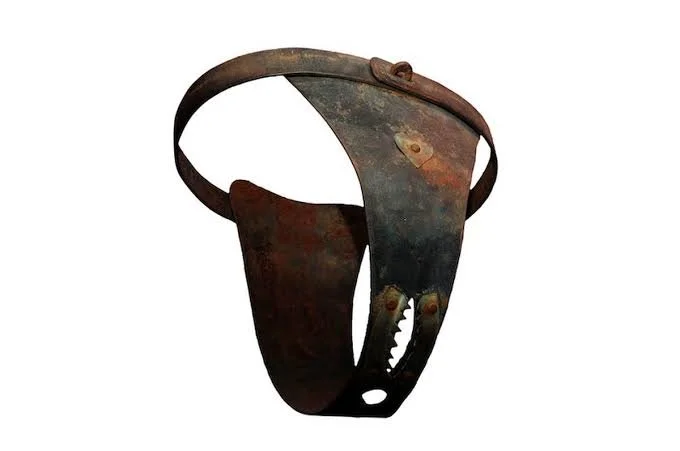Chastity belts are one of the most enduring symbols of the medieval era in popular imagination, often depicted as harsh devices designed to control women’s sexuality. According to myth, women wore these belts to ensure fidelity while their husbands were away—whether on crusades, pilgrimages, or wars. However, a closer look into history reveals that this narrative is far more myth than fact, fueled by satire, misunderstanding, and modern exaggerations.
Origins of the Chastity Belt Legend
The concept of chastity belts first emerged in medieval literature and art but was largely rooted in satire, not serious use. According to historian Albrecht Classen, author of The Medieval Chastity Belt: A Myth-Making Process (2007), the idea likely originated as a literary and comedic device. The first known reference appeared in Bellifortis, a 1405 treatise on siege machinery written by Konrad Kyeser, a German engineer and artist. In this text, Kyeser included the chastity belt in an afterword, seemingly as a tongue-in-cheek addition rather than a practical invention.
At the time, the belt was never described as a real, enforceable item. Instead, it served as an exaggerated joke aimed at poking fun at the idea of controlling women’s bodies in such an extreme way.
A Satirical Obsession in Later Centuries
Despite its lack of historical credibility, the chastity belt became a recurring topic in Renaissance art and literature. Writers and artists of the 16th and 17th centuries used the concept as a humorous allegory for jealousy, distrust, and the absurd lengths to which men might go to control their wives.
By the 18th and 19th centuries, the chastity belt became even more entrenched in public consciousness, not as a medieval relic but as a bizarre artifact of prudery and control. During the Victorian era—a time obsessed with morality and sexual restraint—chastity belts were presented in museums and exhibitions as relics of a "savage" and backward medieval past. These artifacts, however, were often forgeries created to satisfy curiosity or reinforce narratives of cultural progress.
The Lack of Historical Evidence
A critical examination of medieval sources reveals a glaring absence of evidence for the real-world use of chastity belts. Historians and curators have failed to find references in medieval sermons, legal texts, or medical literature—documents that frequently addressed issues of morality, marriage, and the human body. As Albrecht Classen notes, “No author of sermon literature, of penitentiary texts, or didactic and legal writings has ever mentioned the chastity belt probably because the basic idea behind it defies the basic needs of the human (female) body.”
In addition to the textual silence, the physical design of chastity belts casts further doubt on their practical use. Devices depicted or displayed in later centuries would have been deeply impractical and harmful to wear for extended periods. Hard, metallic structures in contact with the groin would inevitably cause wounds, infections, and immense physical suffering. The absence of any reliable records of injuries or medical treatments related to such devices strongly suggests they were never a reality.
Chastity Belts as Misunderstood Artifacts
Museums, particularly in the 19th and early 20th centuries, played a significant role in perpetuating the myth of chastity belts. Many displayed them as legitimate medieval artifacts without questioning their authenticity. However, modern investigations have shown that many of these "medieval" chastity belts were actually constructed centuries later, often as hoaxes or novelties.
For instance, curators at the Semmelweis Museum in Budapest noted in a 2010 exhibition that many supposed chastity belts are Victorian forgeries, created to satisfy a public fascination with the grotesque and bizarre aspects of history. The belts reflect more about the anxieties and imaginations of later centuries than any actual medieval practices.
Why the Myth Persisted
The chastity belt legend persists because it serves as a convenient narrative for exploring themes of control, sexuality, and gender dynamics. It has been widely depicted in art, literature, and film, often as a symbol of extreme patriarchal control or comedic absurdity. The concept fits well into modern critiques of past societies while providing a sensationalized story that captures the imagination.
However, its persistence says more about the biases of those who perpetuated the myth than about medieval reality. The idea of chastity belts reinforces a caricature of the Middle Ages as a period of ignorance and brutality while ignoring the more nuanced realities of medieval culture.
Im conclusion chastity belts are not the medieval instruments of oppression they are often believed to be. Instead, they emerged from satire, myth, and later misconceptions, fueled by the imaginations of Renaissance artists, Victorian moralists, and modern storytellers. While they serve as a fascinating cultural artifact, their historical reality remains firmly debunked. Rather than a reflection of the Middle Ages, chastity belts reveal more about humanity’s tendency to mythologize and sensationalize the past.
For historians and curious readers alike, the chastity belt serves as a valuable reminder: not everything labeled “medieval” or “historical” is as it seems.







